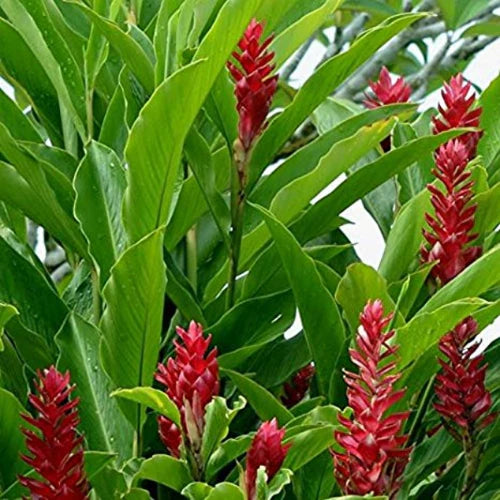Ginger is not only a popular spice, but it is also the world's best natural treatment with several health advantages. Ginger is a herbaceous perennial blooming plant that is widely used as a spice. This herb is employed in the Ayurvedic system for its therapeutic benefits. Ginger is related to turmeric and cardamom. This plant is well suited to warm areas. It develops a cluster of pink and white flower buds. These flower buds open to reveal yellow flowers. It has an annual leafy stem that grows 3-4 feet in height. The color of ginger rhizome varies depending on the variety. It might be yellow, white, or red in color, with brownish skin that can be thin or thick. Ginger rhizome, fresh and dried.
General Information
For thousands of years, ginger has been used as a flavoring spice in food. In Asia, several cuisines call for the fresh stem of this plant as a key ingredient. In British cooking, gingerbread is more common than powdered ginger, which is more common in Europe. Other popular ways to flavor ginger beer and ginger ale with this ginger include ginger oil and oil resin. Even cosmetics, fragrances, and medications have it as an ingredient. In Japan, Beni shoga and gari are made with pickled ginger. In India, ginger is one of the key ingredients in many non-vegetarian cuisines, including numerous meat-based dishes, as well as heavier gravies for vegetarian dishes. Ginger contains zingiberenes, zingerone, a-curumene, citral, D-camphene, and gingerols. Opium is purified with ginger juice (ahiphena shodhana).
Special Note
The several forms of ginger include dried, powdered, fresh, oil, and juice. It is a spice that is extremely widely used. This spice's natural oil, gingerols, gives it a distinct flavor and scent. Due to its therapeutic qualities, ginger is well-known in the medical community. It is extremely potently anti-inflammatory and antioxidant.
Habitat
Although it is primarily an Asian native, ginger is found in tropical areas all around the world. The commercial cultivation of this herb takes place in South Africa. As an alternative medicine, ginger has a long history throughout Asia and the Middle East. Ginger has been used in China to cure dyspepsia for 2000 years. Ginger may now be cultivated indoors.
Ginger grows best on soil that is fertile, wet, and well-drained. Because vital nutrients are trapped in decaying leaves and dead wood in tropical jungles, they flourish freely there.
Category
- Kingdom - Plantae
- Order - Zingiberales
- Family - Zingiberaceae
Names
- Latin name - Zingiber officinale
- English name - Ginger
- Hindi name - Adarakh (fresh)
- Kannada name - Hasi shunti
- Telgu name - Alla, Allamu
- Bengali name - Ada
- Marathi name - Aale
- Gujarati name - Adu
- Tamil name - Shukka, Inji
- Malayalam name - Inchi
- Farsi name - Anjeebeele, tara
- Sinhala name - Amu, inguru
- Arabian name - Janjabeele ratab
- Malaysian name - Halia
- Burma name - Gyin
Ayurvedic Properties
|
Particular |
Hindi / Sanskrit |
English |
|
Rasa (Taste) |
Katu |
Pungent |
|
Guna (Physical Property) |
Guru, Ruksha |
Heavy, Dry |
|
Virya (Potency) |
Ushna |
Hot |
|
Vipaka (Post-Digestive Taste) |
Madhura |
Sweet |
Effects on Doshas
It balances Kapha dosha.
|
Charak Samhita |
Sushrut Samhita |
|
|
Pipalyadi gana, Trikatu |
Practical Uses of Ginger
- The finest appetizer is ginger since it enhances flavor and calms anorexia.
- Because of its aphrodisiac properties, it increases vigor.
- Effective for heart problems, best Ayurveda for cardiac care.
- Enhances digestion and aids in reducing colic pain in the abdomen.
- Since it has an anti-inflammatory effect, it helps to lessen edema and swelling.
- Useful for conditions including asthma and respiratory illnesses.
- Helpful when liver diseases are in their early stages.
- Additionally, it is used to treat elephantiasis and anemia.
- It helps reduce constipation by dissolving minute particles of stiff feces.
- Dizziness, menstruation pain, arthritis, rheumatoid arthritis, weight loss, and motion sickness can all be treated with ginger.
- To treat a headache, the forehead is covered with a dry ginger paste.
Cautions
- People with sensitive stomachs may experience worsening gastritis.
- Using ginger in moderation when pregnant or nursing is safe.
Dosage
- Fresh juice - 5-10ml
- Powder - 1-2gm
- Syrup - 2-5 ml separated in doses
Part Used
Rhizome (Both fresh and dry)

